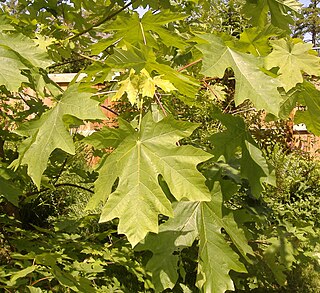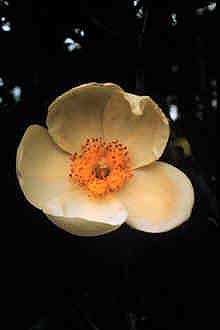Related Research Articles

Acer saccharinum, commonly known as silver maple, creek maple, silverleaf maple, soft maple, large maple, water maple, swamp maple, or white maple, is a species of maple native to the eastern and central United States and southeastern Canada. It is one of the most common trees in the United States.

The honey locust, also known as the thorny locust or thorny honeylocust, is a deciduous tree in the family Fabaceae, native to central North America where it is mostly found in the moist soil of river valleys. Honey locust trees are highly adaptable to different environments, and the species has been introduced worldwide. Outside its natural range it can be an aggressive, damaging invasive species.

Coffee is a beverage brewed from roasted coffee beans. Darkly colored, bitter, and slightly acidic, coffee has a stimulating effect on humans, primarily due to its caffeine content. It has the highest sales in the world market for hot drinks.

The Kentucky coffee tree, also known as American coffee berry, Kentucky mahogany, nicker tree, and stump tree, is a tree in the subfamily Caesalpinioideae of the legume family Fabaceae, native to the Midwest, Upper South, Appalachia, and small pockets of New York in the United States and Ontario in Canada. The seed may be roasted and used as a substitute for coffee beans; however, unroasted pods and seeds are toxic. The wood from the tree is used by cabinetmakers and carpenters. It is also planted as a street tree.

Diospyros virginiana is a persimmon species commonly called the American persimmon, common persimmon, eastern persimmon, simmon, possumwood, possum apples, or sugar plum. It ranges from southern Connecticut to Florida, and west to Texas, Louisiana, Oklahoma, Kansas, and Iowa. The tree grows wild but has been cultivated for its fruit and wood since prehistoric times by Native Americans.

Acer macrophyllum, the bigleaf maple or Oregon maple, is a large deciduous tree in the genus Acer. It is native to western North America. In addition to uses by animals, it is of some culinary and woodworking interest.

Coffee production is the industrial process of converting the raw fruit of the coffee plant into the finished coffee. The coffee cherry has the fruit or pulp removed leaving the seed or bean which is then dried. While all green coffee is processed, the method that is used varies and can have a significant effect on the flavor of roasted and brewed coffee. Coffee production is a major source of income for 12.5 million households, most in developing countries.

The açaí palm, Euterpe oleracea, is a species of palm tree (Arecaceae) cultivated for its fruit, hearts of palm, leaves, and trunk wood. Global demand for the fruit has expanded rapidly in the 21st century, and the tree is cultivated for that purpose primarily.

Taxodium distichum is a deciduous conifer in the family Cupressaceae. It is native to the southeastern United States. Hardy and tough, this tree adapts to a wide range of soil types, whether wet, salty, dry, or swampy. It is noted for the russet-red fall color of its lacy needles.

Kona coffee is the market name for coffee cultivated on the slopes of Hualalai and Mauna Loa in the North and South Kona Districts of the Big Island of Hawaii. It is one of the most expensive coffees in the world. Only coffee from the Kona Districts can be described as "Kona." The weather of sunny mornings, clouds or rain in the afternoon, little wind, and mild nights combined with porous, mineral-rich volcanic soil create favorable coffee-growing conditions. The loanword for coffee in the Hawaiian language is kope, pronounced.

Cocos Island is an island 1 mile (1.6 km) off the southern tip of the United States territory of Guam, located within the Merizo Barrier Reef, part of the municipality of Malesso'. The island is uninhabited, 1,600 meters (5,200 ft) long in a southwest–northeast direction, between 200 m (660 ft) and 300 m (980 ft) wide, and has an area of 386,303 m2. It sits atop the southwestern coral reef rim of Cocos Lagoon.

Frangula californica is a species of flowering plant in the buckthorn family native to western North America. It produces edible fruits and seeds. It is commonly known as California coffeeberry and California buckthorn.
William Edwin Safford was an American botanist, ethnologist, and educator employed by the U.S. Navy and federal government.

Gordonia lasianthus is a small to medium-sized evergreen tree or shrub found in acidic, swampy soils of pinelands and bays on the Atlantic and Gulf Coastal Plains of the southeastern United States. It is a member of the tea or family Theaceae. It is slow growing with soft, light-colored, fine-grained wood of little commercial value, although loblolly-bay could be managed as a source of pulpwood. When older specimens are cut, the wood exudes a strong scent. It is similar to a mixture of fresh oranges and pine sap. The bark of the adult tree varies from medium grey to a red brown coloration. Dead adult specimens of loblolly bay exhibit a lustrous shine when exposed to sunlight for several years. The white showy flowers and shiny foliage make it a desirable ornamental, but it is not easy to cultivate. Deer browse stump sprouts heavily.

Ardisia crenata is a species of flowering plant in the primrose family, Primulaceae, that is native to East Asia. It is known by a variety of names such as Christmas berry, Australian holly, coral ardisia, coral bush, coralberry, coralberry tree, hen's-eyes, and spiceberry. A. crenata is a compact shrub that reaches 1 metre (3.3 ft), often with a single stem. Leaves are dark green, thick, glossy, and have tightly waved edges The flowers are small, white or reddish, fragrant, and form clusters. The fruit is a glossy, bright red drupe. The seeds are able to germinate under a dense canopy and are dispersed by birds and humans.
The elm cultivar Ulmus 'Tortuosa'Host, the Wiggly Elm, was described by Host in Flora Austriaca (1827) as Ulmus tortuosa, from low, twisted, small-leaved trees that grew in the hilly districts of Hungary. A contemporary herbarium specimen (1833) from Central Europe labelled U. tortuosaHost appears to show small field elm-type leaves. Henry distinguished 'Tortuosa' Host from Loddiges' and Loudon's U. tortuosa, which he identified with Ulmus 'Modiolina', "l'orme tortillard" of France. Henry noted, however, that abnormal sinuous or zigzagging growth "might occur in any kind of elm", and herbarium specimens of elms labelled 'Tortuosa' range from U. minor cultivars to hybrid cultivars, some treated as synonymous with 'Modiolina'. A large-leaved U. campestris tortuosa was described by David in Revue horticole (1846), while a hybrid var. tortuosa cultivar from Louveigné, Belgium, with twisted trunk and large leaves, was described by Aigret in 1905. An U. campestris suberosa tortuosa was marketed in the 1930s by the Hesse Nursery of Weener, Germany, by its description a contorted form of corky-barked field elm.

Parkia biglobosa, known in English as the African locust bean, is a perennial deciduous tree in the family Fabaceae. It is found in a wide range of environments in Africa and is primarily grown for its pods that contain both a sweet pulp and valuable seeds. Where the tree is grown, the crushing and fermenting of these seeds constitutes an important economic activity. Various parts of the locust bean tree are used for medicinal and food purposes. As a standing tree, locust bean may have a positive effect on the yield of other nearby crops.

Lindera melissifolia, common name pondberry or southern spicebush, is a stoloniferous, deciduous, aromatic shrub in the laurel family. This endangered species is native to the southeastern United States, and its demise is associated with habitat loss from extensive drainage of wetlands for agriculture and forestry. Restoration efforts are currently being conducted.

Rear Admiral Edward Simpson Jr. was a United States Navy officer who briefly served as the acting 20th Naval Governor of Guam from May 8, 1916 to May 30, 1916. Simpson, commandant of the U.S. Naval Base Subic Bay and the U.S. Naval Station Sangley Point, took the position pending the arrival of appointed Governor Captain Roy Campbell Smith. Prior to his command, he served as a naval attaché to London in 1911.

Syzygium thompsonii is an endemic tree of the Mariana Islands of Guam, Rota, and Saipan with a striking appearance due to its abundance of white flowers and edible fruit that grow directly from the trunk. It is related to the Malay apple but bears smaller tart fruit.
References
 This article incorporates text from this source, which is in the public domain : L. M. Cox's The island of Guam (1917)
This article incorporates text from this source, which is in the public domain : L. M. Cox's The island of Guam (1917) This article incorporates text from this source, which is in the public domain : W. E. Safford's Contributions from the United States National Herbarium (1905)
This article incorporates text from this source, which is in the public domain : W. E. Safford's Contributions from the United States National Herbarium (1905)
- 1 2 Safford 1905, pp. 244–45.
- ↑ Cox, Dorn & McIntosh 1917, p. 14.
- ↑ Safford 1905, p. 244.
- ↑ "Coffee trees being restored around Guam". KUAM News. 2 September 2012. Retrieved 2 September 2012.